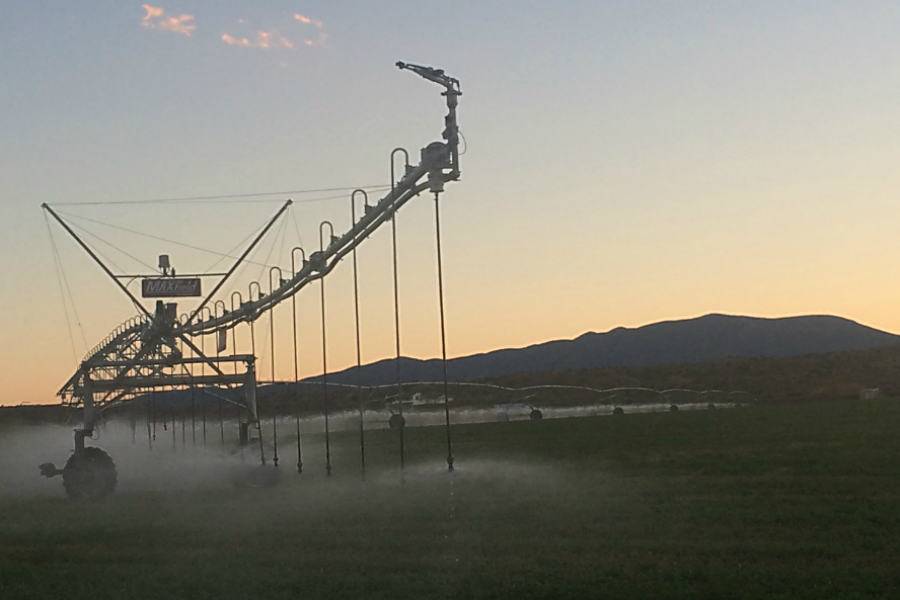America's biggest water users – farmers – learn to use less of it
Loading...
| Scottsdale, Ariz.
Kevin Rogers, a fifth-generation farmer near Scottsdale, sees how technology is helping him use less water. Wearing an off-white cowboy hat while driving his silver truck around his farm, he points to a flood-irrigated field that uses laser-leveling technology. The sensor gathers a signal from satellites to ensure fields are cleared as smooth as possible, preventing water from pooling.
Water efficiency is improving at farms across the West. That’s important because agriculture consumes 80 percent of the nation’s water – and actually more than 90 percent of what’s used in many Western states, according to the US Department of Agriculture.
Agriculture in the Southwest, however, often comes under fire for water use. Vast pasture lands that require water seem out of place in the arid climate. Cotton and alfalfa hay, used largely as feed for cattle, consume a lot of water and are often targets for criticism.
But as Mr. Rogers sees it, the constant heat makes it perfect weather for drought-tolerant alfalfa hay. It gives the region’s farmers steady income while simultaneously underscoring the West’s delicate balance of supporting its legacy economic engine while preserving resources for a bigger, more urban population.
“The Colorado River is probably the best place to farm, and that goes hand-in-hand with technology,” Rogers says. “Farmers are the very first guys to adapt to a new technology because if we can be more productive, if we can do a better job, if we can use less water, produce more crops – all those things – it’s advantageous for us.”
As of 2008, farms use 12 percent less water to harvest an acre of crops, on average, than they did in 1998, according to the most recent USDA data. At the same time, though, total water used on farms declined just under 1 percent as smaller farms consolidated into larger, more industrialized ones.
One way or another, farms are likely to have to keep getting more efficient with their water resources, as rising urban populations intersect with climate change that, scientists say, is making drought years more common in this region. Despite a wet winter in the West, the groundwater aquifers upon which farmers rely remain strained. That will likely be the case for decades.
Efforts to reduce water waste might need to come through policy. Western water rights are awarded to users on a “first come, first served” basis and typically require rights owners to use all their allocation to maintain their rights. On top of that, most states have incomplete data on groundwater or can’t easily verify whether farmers are using more water than allowed.
California, which has poor water data, is implementing a new groundwater management law that policymakers hope will curb waste by establishing a floor for water levels, beyond which restrictions would kick in. But even getting that system established is complicated – big California agriculture producers resisted a centralized program for data collection, instead opting for local information gathering that then must be scaled up and matched with the rest.
Arizona is dealing with similar pressures from agriculture. If there’s ever a Lake Mead water shortage along the Colorado River, the state’s cities are protected but farmers won’t get their full allocation. Amid the strain of a long drought, some state lawmakers have advocated opening water supplies by rolling back a landmark 1980 groundwater conservation law.
But farms across the West are adapting on their own as well. To the north, in cooler but still-dry central Washington, Scott McIlrath is doing just about all he can on his fruit farm.
“Climate change is all it’s been here and no doubt Washington [will] become like northern California in 20 to 50 years, but we’ll just have to adapt to it,” he says.
He’s converted to drip irrigation and uses smaller sprinklers to reduce waste. He now monitors his soil content everyday for moisture. He’s added magnesium and clay in his soil to help mitigate the effects of hotter temperatures by reflecting ultraviolet radiation.
Family-owned farms in the region have every incentive to conserve water, says Mike Walker, who deals with a lot of them as the field manager for fruit marketer Cowiche Growers Inc.
The growing season is coming earlier these days, putting the region’s cherry growers into competition with large, industrialized California farms.
Reusing and reducing water is a way to buffer against that shock while also yielding environmental benefits, Mr. Walker says. On his own farm, he plants cover crops to enrich the soil and uses metered sprinklers to slash water use.
“That’s just being good stewards of the land,” Walker says. “We take care of our runoff. We don’t waste water.”
Reporting for this story was supported by a fellowship at the Bill Lane Center for the American West, at Stanford University.
This is the third article in a series on solving water challenges in the American West.
Part 1: West's challenge is still water scarcity, wet winter or not
Part 2: In arid Southwest, cities expand but use less water
Part 3: America's biggest water users – farmers – learn to use less of it
Part 4: How water swaps help the West manage a precious resource
Part 5: Why solar panels bloom in Southwest's land of hydropower
Part 6: For water users on Colorado River, a mind-set of shared sacrifice










